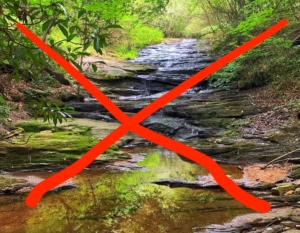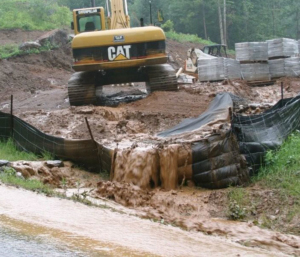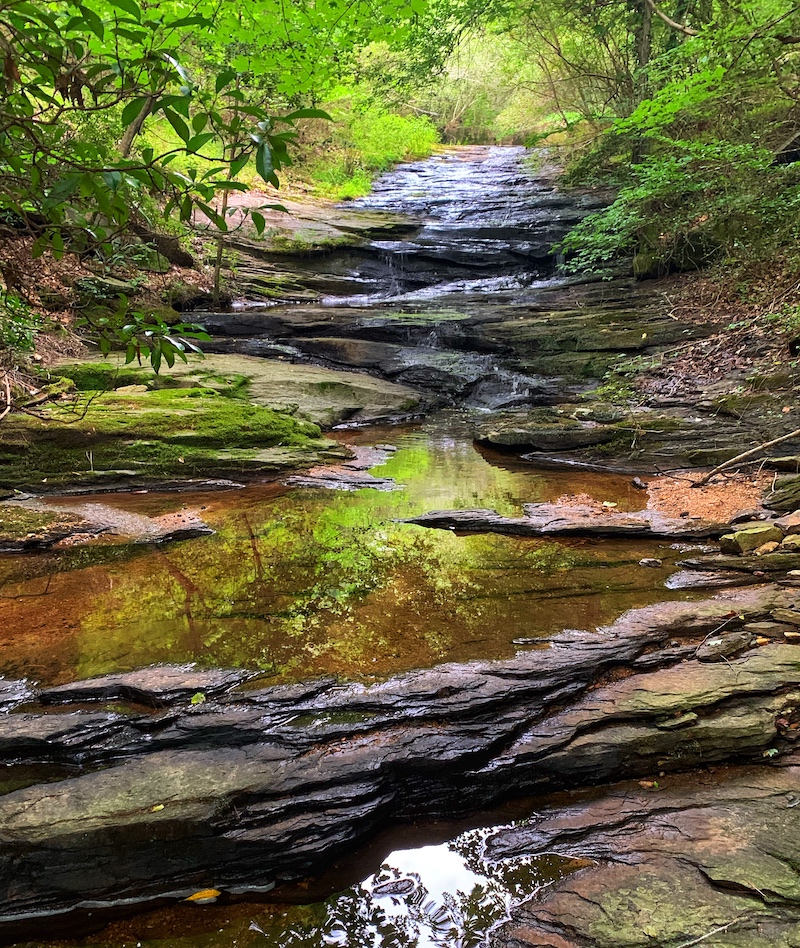
Azalea Falls – On the Verge of Destruction by City Council
Tuesday afternoon, September 15, Council will likely decide the fate of one of Raleigh’s most environmentally significant sites – Azalea Falls, a secluded nine acre site owned by The City of Oaks Foundation and recognized by the NC Department of Natural and Cultural Resources as possessing “natural values justifying its recognition by the State as an outstanding part of the natural heritage of North Carolina”.
Unfortunately, Council is considering an intense apartment project on the steep hills above Azalea Falls – upzoning Z-47-19, at 4800 Duraleigh Rd. These steep hills are part of a larger City-designated “Special Study Area” (one of five in the city) containing a quarry, which will be given to the City in 2052 for park land – unless this Council approves the upzoning for development ahead of time.
According to Raleigh’s Comprehensive Plan, the Special Study Area designation specifies “land use planning studies incorporating focused community outreach are necessary … before approval of development proposals or rezonings“
Any normal Council would heed the citywide significance of the Special Study Area, the ongoing citywide problems with Crabtree Creek’s impaired water quality and stormwater flooding, the citywide significance of protecting the Crabtree Creek Greenway, and the statewide environmental designation of the Azalea Falls property. But this is not a normal Council. This is an anti-environmental Council.
This is not a normal Council. This is an anti-environmental Council.
At the September 1st public hearing on Z-47-19, self-proclaimed environmentalist Nicole Stewart responded to the long list of comprehensive planning and environmental concerns with stony silence. MaryAnn Baldwin was mum as well, hoping no one would mention her looming conflict of interest vote, since her boss Barnhill buys trainloads of aggregate from Z-47-19 landowner, Hanson Aggregates. Patrick Buffkin managed a one liner: “its a very special property”. The remainder of the work – carving up the property like a Thanksgiving Turkey – was handled by David Knight.
Knight acknowledged that the project calls for 4+ story apartments and parking lots packed onto the steep slopes overlooking Azalea Falls and abutting homes to the south. Knight sought to shift the multi-story retaining walls back a bit, in the vain hope that the new development won’t somehow be looking down on the roofs of the neighbors.
 To environmental observers, the Azalea Falls property looked like the Titanic going down, with Knight in charge of rearranging the deck chairs. Nowhere in his comments did Knight acknowledge that the steep wooded slopes will be mass graded and cleared and that rain events during the grading and construction will almost surely lead to uncontrollable stormwater runoff pouring off the site, eliminating all aquatic habitats in its path and turning Azalea Falls stream into a sludge pit.
To environmental observers, the Azalea Falls property looked like the Titanic going down, with Knight in charge of rearranging the deck chairs. Nowhere in his comments did Knight acknowledge that the steep wooded slopes will be mass graded and cleared and that rain events during the grading and construction will almost surely lead to uncontrollable stormwater runoff pouring off the site, eliminating all aquatic habitats in its path and turning Azalea Falls stream into a sludge pit.
According to Raleigh’s Comprehensive Plan, this Special Study Area is one of the most important places in Raleigh to carefully and holistically consider our vision for sustainable citywide growth. Likewise, designation by the Department of Natural and Cultural Resources of this area’s statewide environmental value, and the need to protect the wooded slopes overlooking it, adds immeasurable weight to the need for Council to preserve this land, not strip it bare.
But despite overwhelming evidence that this upzoning should not go forward, this Council seems determined to approve the destruction of our most precious environmental assets for the insignificant benefit of the quarry landowner – one of the largest construction conglomerates in North America.

